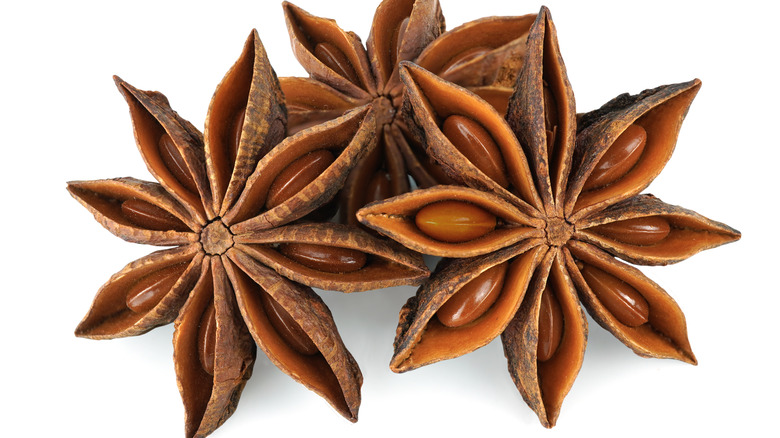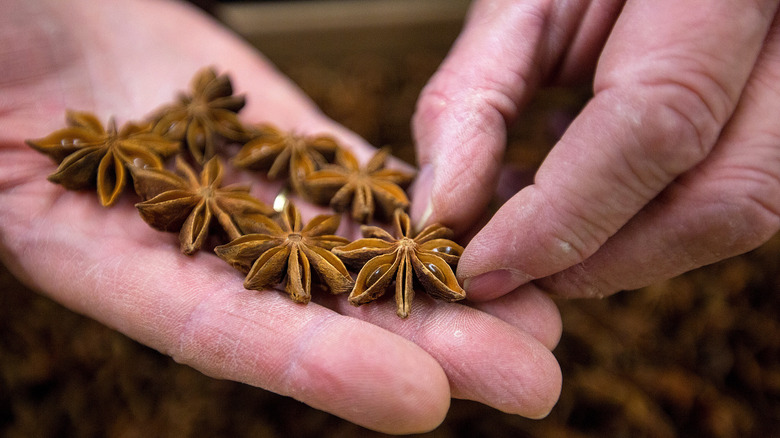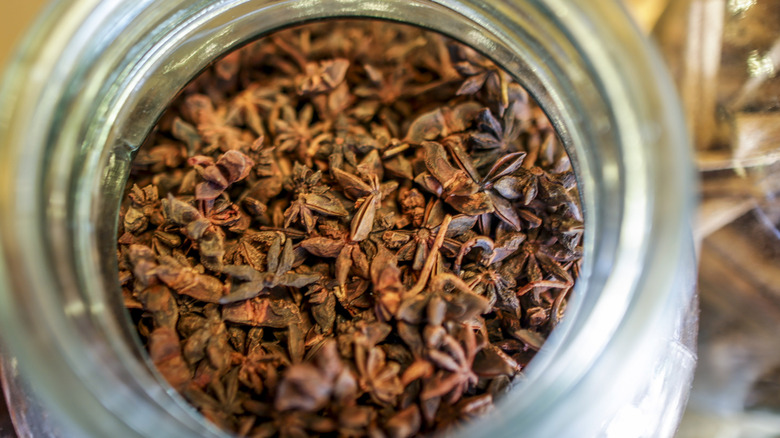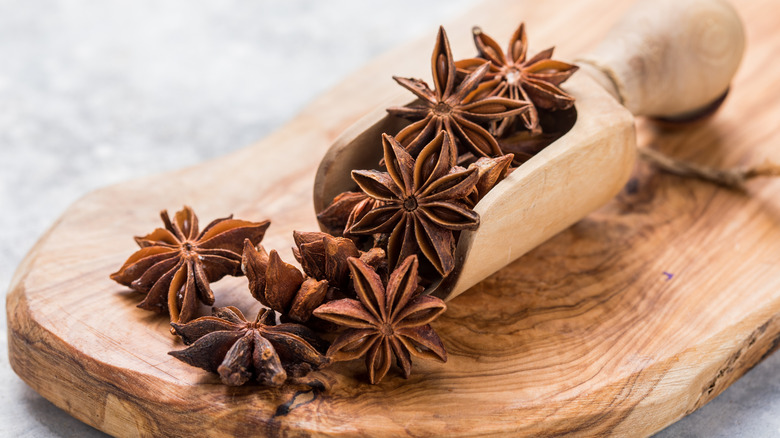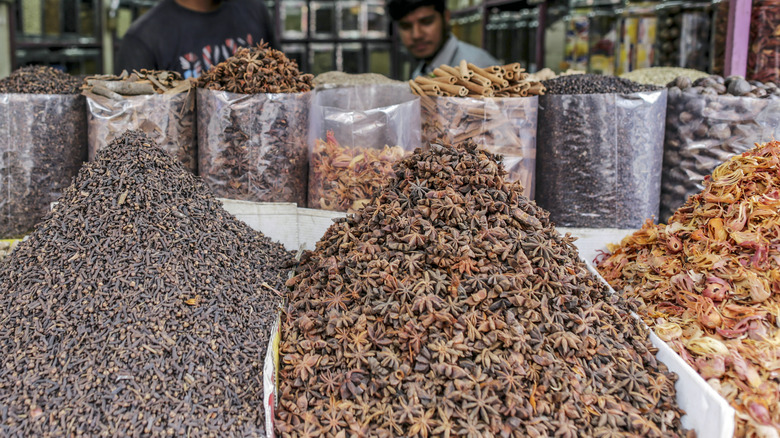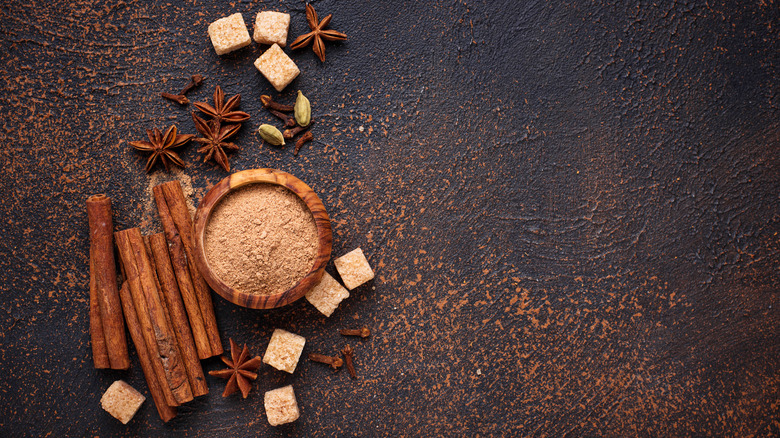What Is Star Anise And What Does It Taste Like?
For many of us, star anise conjures up aromas and flavors of licorice and fennel seed. What dishes we associate with star anise, however, all depends on what we like to cook or grew up cooking. This spice is incredibly versatile, used in everything from savory dishes to liqueurs and desserts. So, what exactly is star anise and how is it different from anise seed?
Star anise is the seed pod from the fruit of the Illicium verum plant. Native to Southwest China, this plant is an evergreen shrub. Star anise gets its name from its shape. These little stars often have eight points, each containing a seed. It's not just the seed that gets used as an ingredient, though. The pod and the seed are both a commodity. Star anise is grown in China, Indo-China, and Japan, and it's sometimes called Chinese star anise.
To get star anise, the pod is picked before it ripens, and then it's sun-dried until it gets to that familiar brown hue.
What does star anise taste like?
Star anise has an aroma and flavor that is warm, sweet, and spicy. It's reminiscent of licorice, fennel seed, clove, and anise seed — which is its own separate seed we'll get to in a moment. Star anise's taste comes from anethole, which is also in anise seed. This oil creates that licorice vibe.
It also possesses some herbal qualities in its flavor and aroma. Because of the herbal, licorice-y, sweet, spicy bouquet going on with star anise, it's often partnered with spices like cinnamon, nutmeg, and ginger. It's also a good match for the brightness of citrus, and brings sweet warmth to savory meat dishes. It's a key ingredient in Chinese cuisine and is part of the quintet known as Chinese five-spice powder — a mixture of star anise, cinnamon, ground cloves, fennel seed, and Szechuan peppercorns.
Where does star anise come from?
Star anise trees are evergreen trees closely related to the magnolia tree. Specialty Produce says that it takes 15 years for these plants to produce the pods of seeds. These trees are native to southern China and northern Vietnam.
According to The Spruce Eats, star anise has been used as a medicine as well as a spice for over 3,000 years in Asia. It made its way to Europe in the late 16th century, after an English sailor brought it back from his travels. Star anise became an in-demand spice that was traded along the tea route, which brought goods from China through Russia.
Star anise can be grown in the United States, but not in the north since it cannot withstand frost and needs almost full sunshine or at least partial sunshine. Most star anise still comes from China and Japan.
Star anise vs. anise seed
Star anise is often confused with anise seed, and that's not without good reason. Both have that licorice-like flavor and aroma, and, of course, both have quite similar names. They're not, however, the same thing. They're not even from the same plant family, believe it or not.
While star anise is from the magnolia family — remember, it comes from those evergreen trees — anise seed hails from the parsley family, specifically from the Pimpinella asinum plant. Compared to how star anise looks, aniseed is smaller and looks more like fennel seed — think little brownish-green teardrop shapes. It's native to Egypt, the Middle East, and Europe, and is used in desserts and charcuterie.
Star anise is actually cheaper to produce, so more often, when things are flavored with anise, it's with the oil of star anise rather than anise seed.
One other important distinction is that star anise is not the same as Japanese star anise, which is from the plant Illicium anistatum. That star anise is very toxic, and might be burned as incense but is never consumed, per NC State.
Does star anise have health benefits?
Smithsonian Magazine writes that star anise is an important ingredient in Tamiflu, a drug that fights influenza. This is because of something in star anise called shikimic acid, which more recently, scientists have figured out to produce on its own.
In addition to that shikimic acid as well as the aforementioned anethole that creates the licorice-esque flavor, star anise has linalool, quercetin, gallic acid, and limonene. What exactly does that mean? These are all bioactive compounds, according to Healthline. Bioactive compounds may have antioxidant, anti-inflammatory, and antimicrobial properties.
Nutritional values of star anise aren't a huge factor in any diet considering that a pinch of star anise in any meal amounts to such a tiny quantity. Research into star anise's exact health benefits is also still in the early stages. Testing has revealed star anise may have antibacterial, antifungal, antiviral, and even anti-cancer properties. Star anise has been used for so many centuries in traditional Chinese medicine, as a digestive aid.
Where and how to buy star anise
You can get star anise in whole pods or ground into a powder. Ground star anise is obviously quick and convenient but may lose its flavor and aroma more quickly. For maximum impact, you want to get whole pods and ground them (pods and seeds all together) yourself right before you cook with them. The other slightly more tricky element to this is that ground star anise is usually readily available in the spice aisle of any supermarket, whereas you will probably have to go to a specialty store for whole pods. Look for shops that concentrate on Asian and/or Indian foods and cooking.
If you cannot find star anise, some good candidates for substitutions include anise seed, as well as fennel seed, or the Chinese five-spice powder.
To keep your star anise fresh and potent, keep it in an air-tight container and avoid moisture, heat, and/or sunlight. That goes for both the whole pod and ground powder forms. The whole pods will still pack a punch for a year or so, compared to the ground version's six months.
How to cook with star anise
Star anise is used in everything from Chinese cuisine to Vietnamese pho, Indian biryani, spiced chai, cookies, jams, liqueurs, sauces, and soups. Often, you're using the powder form, which is ideally fresh-ground if you can find the pods. However, in things like broths and marinades for meat, you might use whole pods during the actual cooking time, in which the star anise will lend its flavor and aroma. Just remember to take the pods out before serving and eating.
Chinese five-spice powder and star anise go well with fattier meats, according to Spiceography, including duck, goose, and pork. In addition to whole pods for braising meat or ground powder in sauces, star anise's harmony with citrus makes for great vinaigrettes. On the dessert side of things, star anise brings lovely complexity to gingerbread, apple pie, spice cake, and anything else along those lines, like carrot cake.
Two important things to remember when you use star anise are: use it in moderation and don't cook the whole pods for too long. This spice can easily overpower all the other flavors in a dish.
